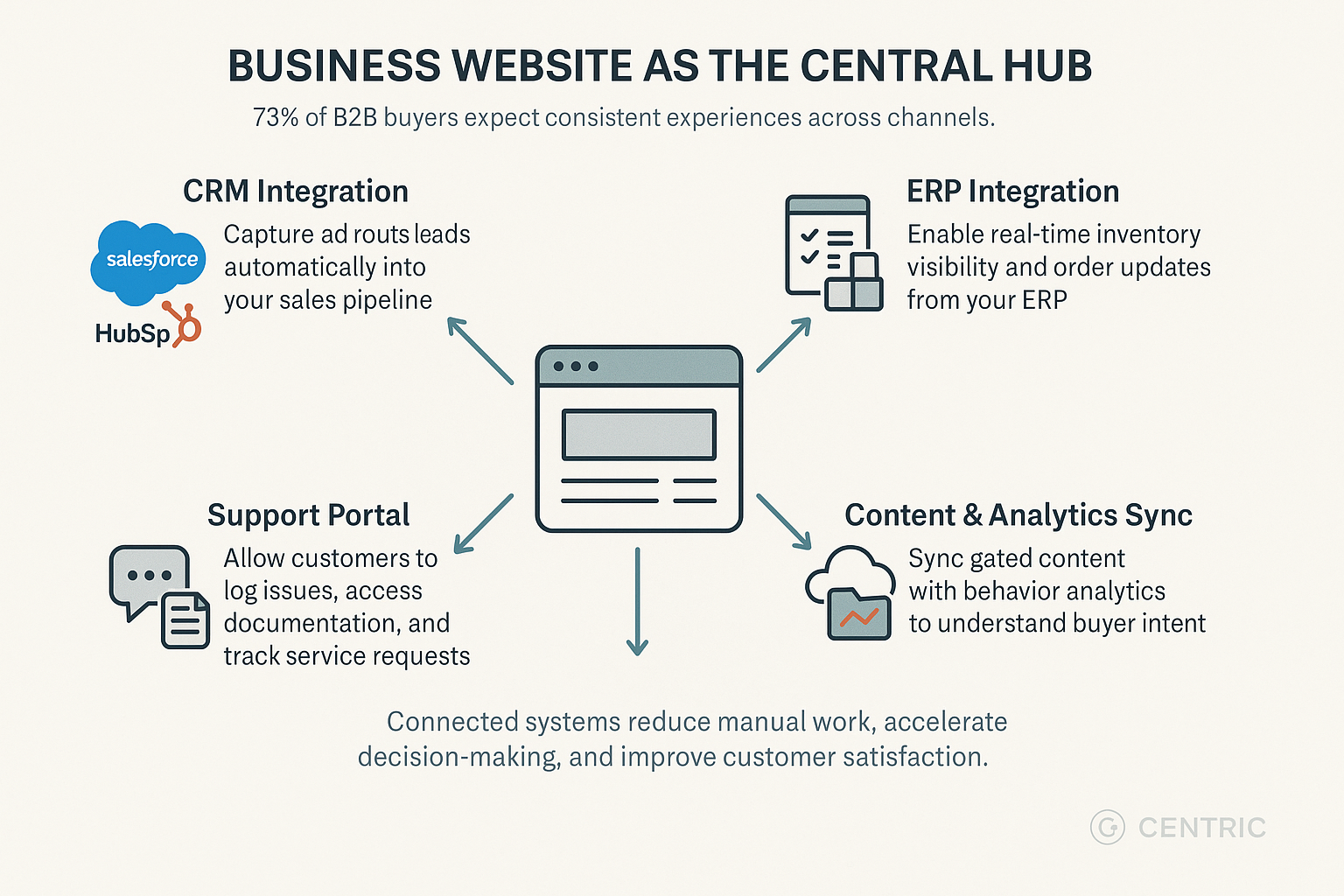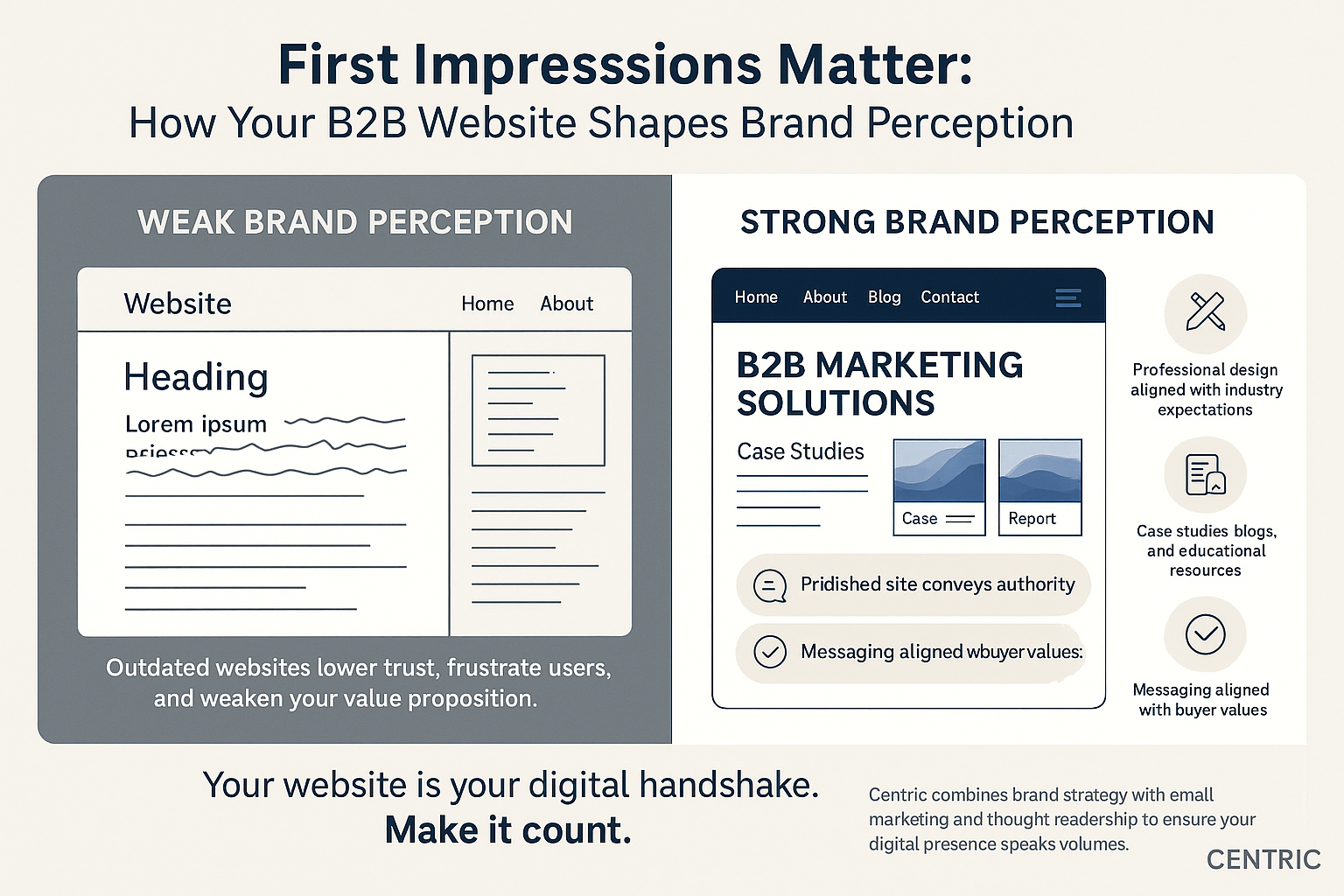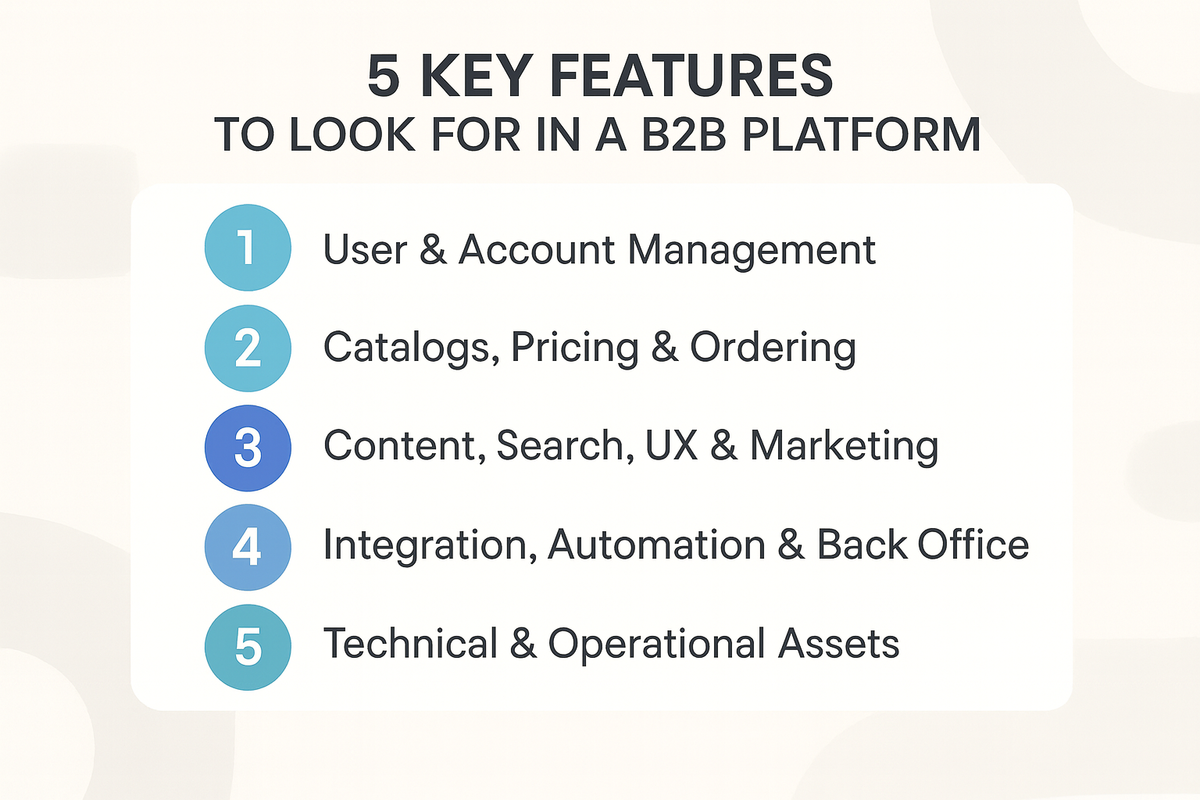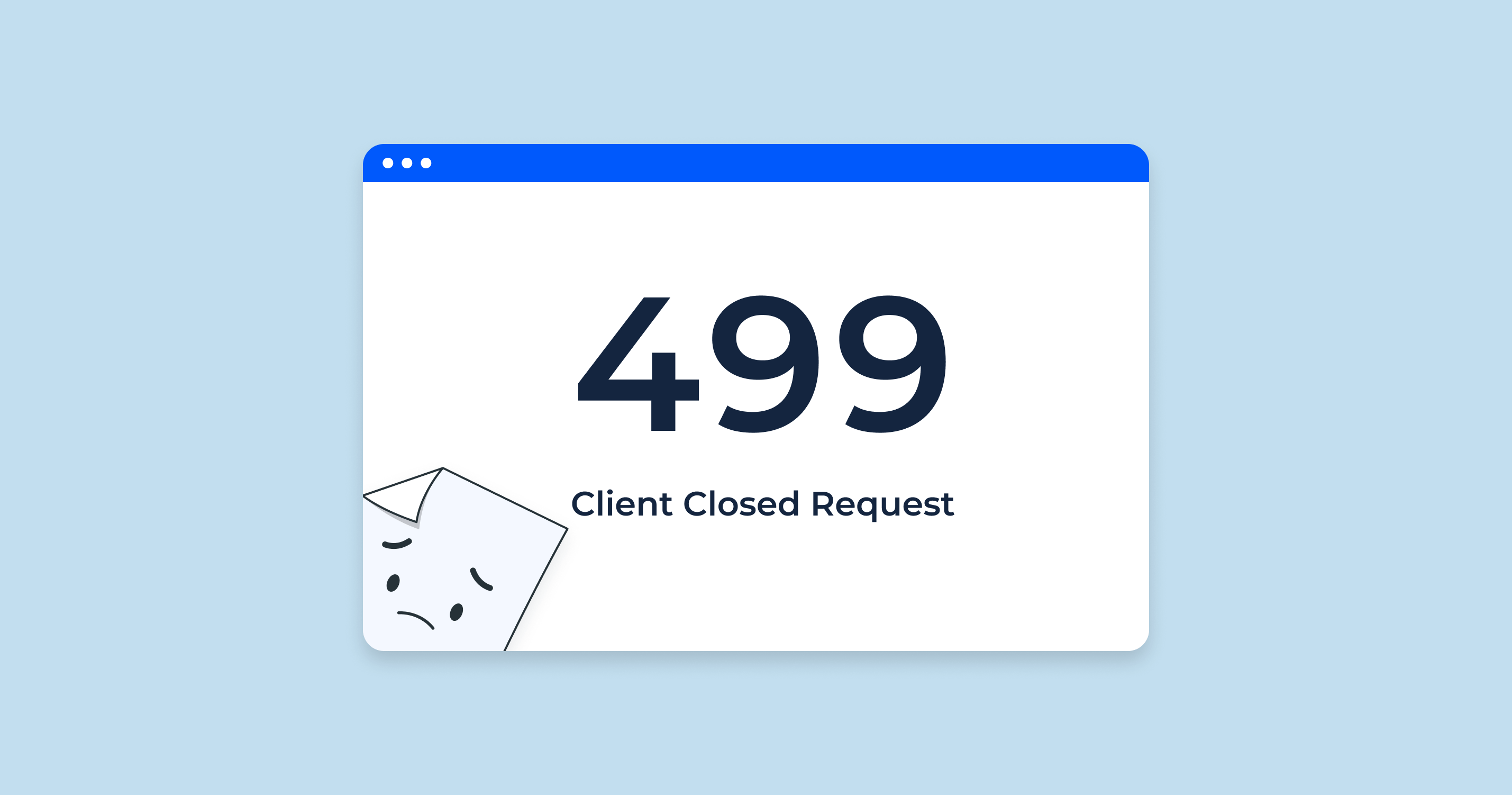Why your website is a B2B business asset, not just an online presence? A B2B company’s website is no longer just a digital brochure, it’s the central hub of your revenue strategy, the front line of your customer experience, and the core of your brand authority. In today’s market, where more than 70% of B2B buyers conduct in-depth research before even reaching out to a sales rep (Forrester), your website is often your first and only chance to make a compelling impression.
Yet B2B websites face greater complexity than their B2C counterparts. Buyers aren’t making emotional or impulse purchases, they’re evaluating technical fit, compliance, ROI, and long-term partnerships. Add to that longer buying cycles and multiple stakeholders, and it’s clear that a generic website just doesn’t cut it.
That’s why strategic B2B website development is no longer optional, it’s a necessity. A well-designed and technically sound website helps your organization generate leads, accelerate decision-making, and scale with confidence.Platforms that provide the benefits of B2B website development enable you to create a tailored experience that addresses these complex needs, ensuring your business stays ahead of the competition. Let’s explore how.
What is B2B Website Development?
B2B website development refers to the comprehensive process of building a website for a business-to-business (B2B) company. This process involves everything from the initial website coding to the design elements like color schemes, typography, and user experience (UX), much like What are Some Benefits of the Agile Development Methodology in iterative web development? Whether you’re designing a website for a small B2B startup or a large enterprise, the goal is to create a platform that is both functional and user-friendly, allowing for seamless interactions between businesses. This is where the benefits of custom web development for B2B companies truly shine, as it ensures that the website is tailored to meet specific business needs, enabling more efficient and impactful interactions. The difference between B2B and B2C website development lies in the unique needs and complexities of business-to-business transactions, such as longer buying cycles, multiple stakeholders, and a focus on ROI and compliance.
It's important to note that web development is distinct from web design. While web design focuses on the visual elements of a site, such as layout, color, and branding, web development encompasses all aspects of website creation. This includes both the visible design components and the underlying code that powers the site’s functions.
What Are B2B Website Development Platforms?
A B2B website development platform is a software system, CMS + e‑commerce + content + portal layer, built for companies selling to other businesses (not just end consumers). It enables you to build and run a website (or web portal) that supports:
- Business‑to‑business interactions: corporate accounts, multiple user roles, repeat buying, contracts.
- Self‑service & transactional features: quoting, ordering, account management, bulk purchases.
- Integrations with enterprise systems: CRM, ERP, inventory, shipping, invoicing.
- Marketing + sales plus operational processes for B2B flows.
A B2B e-commerce website typically includes custom pricing, bulk ordering, detailed product info, and self-service portals to help businesses manage their accounts and orders, which is crucial when considering how to launch a New Product successfully. Additionally, the platform helps to manage B2B portal software, allowing businesses to offer self-service and transactional features that simplify ordering and account management.
B2B web development refers to creating a website that acts as the central hub for digital marketing, lead generation, and business operations like order management, invoicing, and customer communication. It streamlines processes and improves efficiency.
Top 7 Benefits of B2B Website Development Platforms
B2B website development platforms offer numerous advantages for businesses looking to build or enhance their online presence. Here are some key benefits:

1. Strategic Lead Generation and Qualification
Lead generation is the most visible and measurable return on B2B web development. But unlike in B2C, where a product can be purchased instantly, B2B leads must be nurtured, qualified, segmented, and directed through a multi-stage journey. When looking at what are five marketing strategies that retailers spend half of their annual budget on?, many of these strategies, like targeted digital ads and SEO optimization, are critical for B2B lead generation too.
Your website is the first step in that process. A well-architected site uses smart design and embedded marketing tools to capture intent and guide prospects toward action. For example, a SaaS company might use a free demo form that directly connects with a marketing automation platform, allowing sales teams to instantly qualify and prioritize leads.
For more complex industries like logistics or industrial services, the website can also offer tools like pricing estimators or product configurators that both engage users and pre-qualify them based on criteria like order volume or geography.
Effective lead generation strategies include:
- Dynamic CTAs that adapt to visitor behavior or industry
- Gated content like whitepapers, case studies, or calculators
- CRM-enabled forms that automate scoring and segmentation
- Email marketing automation workflows triggered by user actions
Every page on your site should support a conversion goal. Whether it’s downloading a resource, booking a consultation, or requesting a quote, the key is to guide prospects toward meaningful interactions.
2. Seamless Integration with Business Systems
Your website doesn’t operate in a vacuum. It’s part of your larger business ecosystem, and when built properly, it acts as the glue that connects your marketing, sales, operations, and customer service teams.

For example, an ERP integration can allow real-time order tracking or inventory updates right from the website interface. A CRM integration ensures that lead data flows instantly into your pipeline. These integrations are a key part of B2B web application development, which streamlines processes and ensures that businesses can efficiently manage their operations. Support platforms can plug into client portals, allowing customers to submit tickets or download documentation.
These back-end connections do more than increase operational efficiency, they elevate the customer experience by delivering immediate, relevant information. Advertisement examples of such integrations can be seen in how large retailers use their websites to deliver targeted campaigns that are customized in real-time.
Smart integration strategies may include:
- Synchronizing account-based marketing data with Salesforce or HubSpot
- Allowing distributors or partners to log in for access to pricing or support
- Integrating a support portal for real-time service requests and tracking
- Syncing downloadable content with analytics to measure buyer intent
When your site is connected across your tech stack, teams stop duplicating work, and users get a seamless experience across every touchpoint.
Explore Our B2B Website Development Services!
3. Enhanced User Experience Across Buyer Roles
B2B sales involve layers of decision-makers, engineers, procurement managers, IT leaders, CFOs, and CEOs. Each stakeholder has different goals and pain points. That’s why user experience must be thoughtfully tailored, not just visually appealing.
Take, for instance, an oilfield services provider. While procurement officers may be looking for ISO compliance and safety certifications, field engineers might need access to technical manuals. Meanwhile, C-level decision-makers are focused on cost savings and operational impact. A well-designed B2B website accounts for all these needs by offering intuitive navigation and segmented content journeys.
Persona-based content strategies, particularly those supported by account-based marketing strategies, are essential here. What is B2C sales? It’s a model where consumers directly purchase products, but B2B has a much more complex buying process with multiple stakeholders involved.
When done right, your website becomes more than a static resource, it turns into an interactive, role-based digital experience.
Key user experience features include:
- Personalized landing pages or resource hubs by role or industry
- Mobile-first design that accommodates executives on the go
- Clear pathways that reflect awareness, consideration, and decision stages
- Interactive tools and gated assets that reflect buyer intent
This level of experience design increases engagement and lowers drop-offs. The more aligned your site is with the way your buyers think, the better it performs.
4. Scalability and Performance for Growth
Many businesses build websites that are “good enough” for today, but struggle when it's time to scale. Whether you're entering new markets, adding services, or expanding globally, your website must be built to grow with you, not hold you back.
Scalability goes beyond just adding pages. It involves planning the site architecture, CMS flexibility, data integrations, and even performance optimization to handle traffic spikes and future expansion.
Let’s say a mid-sized manufacturing firm begins selling to clients in the Middle East and Southeast Asia. Suddenly, their website needs multi-language support, regional compliance sections, and localized CTAs. Without a scalable backend, this growth becomes a time-consuming and costly challenge. Best SEO reporting tools can track your website's performance and help identify areas for improvement during the scaling process.
Scalable development strategies include:
- Modular frameworks that allow new pages and features to be added easily
- Internationalization support for multi-region operations
- Cloud hosting and CDN integrations for improved load times and uptime
- Future-ready SEO architecture that accommodates growth
When scalability is baked in, your digital infrastructure becomes a long-term business enabler rather than a recurring cost.
5. Improved SEO Visibility and Authority
Search engine visibility is foundational to digital success. It’s how prospects discover you during the research phase of their buying journey. Yet in B2B, SEO is less about chasing high-volume keywords and more about targeting high-intent, solution-oriented queries. This is why B2B ecommerce website development must prioritize SEO optimization, ensuring that the website not only ranks well but also delivers relevant, high-quality content to attract the right buyers.

A user searching “Google keyword ranking” isn’t just browsing; they’re evaluating their options. The key to capturing that attention lies in building a technically sound site that speaks their language and answers their questions.
SEO-driven B2B development involves a blend of technical foundation and content strategy. Your site must load quickly, be mobile responsive, have clean URLs, and include schema markup to help search engines understand your content.
SEO optimization techniques include:
- On-page and technical SEO to ensure crawlability and ranking potential
- Long-tail keyword targeting with strong buyer intent
- Topic clusters and pillar content around services and industries
- Structured data and markup for enhanced search results
If your ideal buyer can’t find you when they’re ready to buy, you’re not just missing traffic, you’re missing revenue. Organic SEO services are key to ensuring your site remains visible and relevant over time.
6. Personalized Digital Experiences That Convert
One-size-fits-all content is a thing of the past. Today’s B2B buyers expect your website to recognize who they are, what industry they’re in, and why they’re visiting.
In fact, 73% of B2B buyers expect websites to offer personalized experiences (Accenture). How to get into digital marketing? Well, personalized content is one of the first things marketers need to consider when building websites aimed at B2B buyers.
That’s why modern platforms leverage behavioral data, CRM syncs, and ABM strategies to dynamically adjust what visitors see, from headlines and CTAs to downloadable assets and chatbot responses. This is a key component of B2B web design services, which focus on creating tailored, engaging experiences for every visitor.
Imagine a returning prospect from a Fortune 500 company seeing a tailored case study for their industry. Or an engineer accessing technical specs without needing to dig through general content. This level of customization deepens engagement and builds trust fast.
Personalization approaches might include:
- Dynamic content blocks based on role or browsing behavior
- Geo-location logic for region-specific compliance messaging
- Integration with LinkedIn marketing solutions for account-targeted messaging
- Client portals showing order history, reports, or custom dashboards
Personalization isn’t just a trend, it’s a competitive advantage that moves prospects closer to conversion.
7. Stronger Brand Perception and Competitive Edge
In B2B, your website is often the first and strongest representation of your brand. A slow, outdated, or disorganized site can damage credibility faster than a failed sales call. On the other hand, a refined, strategic digital experience reinforces trust and signals that your business is modern, stable, and ready to deliver.

Great web development bridges the gap between function and form. It reflects the authority of your brand while delivering a seamless user experience. Through consistency, content, and visual storytelling, your website becomes a silent but powerful ambassador for your business.
Centric’s email marketing services and thought leadership programs are a great example of how brand voice can be extended from design to messaging, ensuring every page speaks in a way your audience understands and respects.
Brand-building website features include:
- Professional design aligned with your brand tone and industry expectations
- Case studies, reports, and educational content that showcase credibility
- Clear, confident messaging aligned with your value proposition
- A consistent look and feel across every user interaction
Your brand perception is being formed before your team even says hello. Make sure your website leaves the right impression.
5 Key Features to Look For in a B2B Platform
When evaluating or developing a B2B (Business-to-Business) website, there are several important features that you should consider. These features are grouped into functional categories, which can significantly impact the performance and user experience of the platform.

1. User & Account Management
-
Roles and Permissions: A B2B platform should have the ability to assign different roles (e.g., buyer, approver, finance) with varied access permissions. This ensures that each user can only access the functionalities relevant to their role, enhancing security and streamlining workflows.
- Corporate Account Structures: Support for managing complex organizational structures, such as parent companies, sub-units, branches, and multiple users under one corporate account, is essential for larger businesses.
- Self-Service Portals: A self-service portal allows buyers to view their past orders, reorder items, manage user roles, and track shipments without needing assistance from sales representatives. This can greatly improve efficiency and reduce administrative overhead.
2. Catalogs, Pricing & Ordering
- Differentiated Catalogs & Pricing: A robust B2B platform should allow you to display different products and pricing for different customers. This feature is crucial for businesses that negotiate custom pricing for various clients.
- Bulk Ordering, Quick Reorder, Repeat Purchases: B2B businesses often deal with high-volume orders. Platforms should support bulk ordering, order templates, and quick reordering to streamline the purchasing process for frequent customers.
- Quotes & Negotiated Orders: The ability to submit quote requests, accept negotiated terms, and display contract pricing is important for businesses that work with custom orders or special pricing arrangements.
- Inventory & Fulfillment Integration: Real-time integration with inventory systems ensures that product availability, lead times, and backorders are visible to customers, providing transparency and enhancing trust.
3. Content, Search, UX & Marketing
- Strong Navigation & Search: A well-structured navigation system and powerful search functionality are essential for B2B websites, as buyers often look for specific parts, products, or solutions. An intuitive search experience will improve customer satisfaction and conversion rates.
- Content Suited to Decision-Makers: B2B platforms should provide high-quality content that addresses the needs of decision-makers. This may include case studies, product specifications, whitepapers, and ROI calculators that help businesses evaluate products and make informed decisions.
- Mobile-Optimized / Responsive Design: With an increasing number of B2B buyers browsing and making purchases from mobile devices, ensuring your platform is mobile-optimized is crucial for a seamless user experience across devices.
4. Integration, Automation & Back Office
- CRM/ERP/Inventory/Accounting Integrations: A B2B platform should integrate smoothly with existing CRM, ERP, and accounting systems to sync orders, pricing, customer data, and inventory management. This eliminates the need for manual data entry and reduces errors.
- Workflow Automation: Automating purchasing workflows, approvals, order statuses, and notifications improves operational efficiency and ensures that tasks are handled promptly.
- Analytics & Business Intelligence: An effective B2B platform should provide analytics and reporting tools to help businesses understand customer behavior, purchase patterns, and overall performance. This data can be used to optimize marketing strategies, sales efforts, and inventory management.
5. Technical & Operational Assets
- Scalability & Performance: As your B2B business grows, the platform should be able to handle an increasing catalog size, high traffic volumes, and large numbers of transactions without compromising on performance.
- Security & Compliance: Ensuring that the platform complies with relevant security and data protection standards is crucial. Secure login mechanisms, encryption, and data privacy features protect sensitive corporate data.
- Flexibility/Customizability: B2B businesses often have unique requirements. Therefore, a flexible and customizable platform that can adapt to specific needs, workflows, and business models is essential.
- SEO & Online Visibility: Even in B2B, online visibility is critical. The platform should support SEO-friendly practices to help improve rankings on search engines, driving organic traffic to the site.
What is the Typical Development / Implementation Process?
Implementing a B2B website, whether by using an off-the-shelf platform or developing a custom solution, typically follows these steps:
- Define Goals: Determine what the website must achieve (e.g., lead generation, account portal, ordering).
- Plan Sitemap & Architecture: Map out sections, user flows, account flows, and ordering processes.
- Domain & Branding: Choose a domain, align with branding, and ensure credibility.
- Backend Development: Build integrations with systems like CRM/ERP, define data models, set up user roles, and ensure security.
- Frontend Development: Design a user-friendly UI/UX, ensuring mobile responsiveness and easy navigation.
- Testing & Launch: Perform quality assurance (QA), fix bugs, and do a soft launch before the full rollout.
- Post-Launch Optimization: Analyze performance metrics, refine user experience, add new features, and update content as needed.
4 Types of B2B Website Development Platforms
- E-commerce Platforms: These are specialized platforms for creating B2B e-commerce websites. Examples include Shopify Plus, Magento Commerce, and BigCommerce.
- Content Management Systems (CMS): Platforms like WordPress or Drupal are commonly used with custom development to suit B2B needs.
- Custom Development Frameworks: Agencies or in-house teams may choose custom-built solutions using frameworks like Laravel or Django to meet specific business requirements.
- Headless Commerce Platforms: These are modular platforms that separate the front-end and back-end for greater flexibility and personalization (e.g., commercetools).
How to Choose a Platform / Vendor (Especially in Your Locale)?
When choosing a platform or vendor for a B2B website, especially in regions like Pakistan or South Asia, there are several factors to consider: localization, scalability, and integration readiness are key. Ensure the platform supports your region's language and currency needs. Additionally, consider whether the platform offers advanced B2B portal development features, which allow for customized workflows and tailored user experiences that suit your specific market needs.
There are several factors to consider:
- Localization & Currency: Ensure the platform supports local currency (e.g., Pakistani Rupee) and integrates with regional payment gateways and tax systems.
- Scalability: As your business grows, choose a platform that can handle increasing traffic and order volume.
- Integration Readiness: Verify that the platform integrates easily with your existing CRM, ERP, and accounting systems.
- Vendor or Agency Expertise: Opt for a vendor with a proven track record in B2B solutions to avoid issues with complex workflows.
- Budget & TCO: Consider not just the initial build cost but also the ongoing maintenance, customizations, hosting, and updates.
- Mobile UX: Ensure that the platform provides a seamless experience for business buyers, particularly those using mobile devices.
- Support & Training: Look for platforms that offer robust support and training for your team to manage the platform independently.
- Security & Compliance: Ensure that the platform adheres to regional data protection regulations.
- SEO & Marketing Readiness: The platform should allow for effective SEO strategies to drive organic traffic and enhance your marketing efforts.
- Future-Proofing: Choose a platform that can evolve with your business needs and support new technologies and channels.
8 Common Mistakes / Pitfalls to Avoid
- Using B2C Templates for B2B: B2C platforms often lack the advanced features required for B2B, such as role management and custom pricing.
- Underestimating Complexity: Managing multiple user roles, pricing scenarios, and workflows can be complex and should be planned for early.
- Poor Integration: Without proper integration with back-office systems, businesses can face manual data entry errors and inefficiencies.
- Neglecting Mobile Optimization: Ensure that your platform is fully optimized for mobile devices, as many B2B buyers will use them.
- Over-Customizing: Avoid over-complicating the platform before testing core user flows and determining the essential features.
- Inadequate Testing: Launching without thorough testing of all features, including user roles, order flows, and pricing, can lead to major issues post-launch.
- Failing to Plan for Ongoing Maintenance: After the site is built, continuous maintenance and optimization are essential to keep the platform running smoothly.
- Choosing a Vendor Without B2B Experience: A platform built for consumer-facing businesses may not be suitable for the unique needs of a B2B site.
Frequently Asked Questions
What is B2B Website Development?
B2B website development involves creating online platforms that enable businesses to engage with and transact with other businesses.
What are the Benefits of B2B?
B2B offers higher transaction volumes, long-term relationships, a targeted audience, and better profit margins.
What are the 7 P's of B2B?
The 7 P's of B2B are Product, Price, Place, Promotion, People, Process, and Physical Evidence.
What Makes a Good B2B Website?
A good B2B website is user-friendly, mobile responsive, has a clear value proposition, provides easy contact options, includes lead generation tools, and features trust elements like testimonials and secure payments.
Why Should B2B Companies Invest in Custom Website Development?
Custom sites are tailored to the complexities of B2B buying, integrate seamlessly with internal systems, and scale with long-term business goals.
How Does a B2B Website Help With Lead Generation?
By using gated content, smart CTAs, and CRM-enabled forms, your site becomes a round-the-clock lead qualification machine.
Can a B2B Website Integrate With ERP or CRM Systems?
Yes, Integrations with platforms like HubSpot, Salesforce, or SAP help automate processes and improve customer data flow.
What Role Does Personalization Play in B2B Websites?
Personalization increases engagement and trust by delivering relevant content to each user based on role, behavior, or account data.
How Does B2B Web Development Improve SEO?
Through fast-loading, mobile-optimized design and development, structured content, and long-tail targeting, SEO-optimized websites attract high-value traffic organically.
Conclusion
A high-performing B2B website is no longer a “marketing expense”, it’s a revenue enabler. From increasing qualified leads and shortening the sales cycle to strengthening your brand and scaling operations, it plays a critical role across your entire business. Platforms that offer the benefits of B2B website development give your business the tools to not only stay competitive but also enhance its market presence.
At Centric, we build digital platforms that do more than look good, we create strategic ecosystems that align with your goals and drive results. Whether you're launching a new product, expanding globally, or simply modernizing your presence, your website should work as hard as your team does. We build digital platforms that do more than look good, we create strategic ecosystems, powered by integrated Digital marketing services, that align with your goals and drive results.









